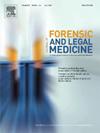比较胸腔积液比和溺水指数在识别淡水溺水死亡中的诊断效用
IF 1.2
4区 医学
Q3 MEDICINE, LEGAL
引用次数: 0
摘要
背景:由于缺乏任何病理解剖结果,在尸检期间诊断溺水仍然是一项具有挑战性的任务。最近的方法提出了定量指标,如胸腔积液比(PE Ratio)和溺水指数(DI),以提高诊断的准确性。PE的定义是胸腔积液的重量除以胸腔积液和肺的总重量,再乘以100。DI定义为肺重量和胸腔积液重量之和除以脾脏重量。方法本前瞻性横断面尸检研究评估了179例医学-法律案例,包括75例淡水溺水,64例心源性猝死和40例绞刑。所有溺水事件都发生在统一环境条件下的冰川河流中。利用脏器和胸腔积液的重量计算PE比和DI。统计分析包括方差分析、Kruskal-Wallis检验、事后检验和受试者工作特征(ROC)曲线分析。结果PE比平均值为29.57,具有较好的诊断价值,AUC为1.0,在截断值为7.4时达到100%的敏感性和特异性。与对照组相比,溺水病例的DI也显着升高(平均值:14.8),AUC为0.828,敏感性为86.7%,特异性为70.2%,临界值为9.7。结论PE比是一种简便、可靠、准确度高的淡水溺水诊断工具。虽然DI的特异性略低,但它提供了有价值的补充信息,特别是在胸膜液评估有限的情况下。本文章由计算机程序翻译,如有差异,请以英文原文为准。
Comparing the diagnostic utility of the Pleural Effusion Ratio and the Drowning Index in identifying freshwater drowning deaths
Background
Diagnosing drowning during post-mortem examination remains a challenging task due to the absence of any pathognomonic autopsy findings. Recent approaches have proposed quantitative indices, such as the Pleural Effusion Ratio (PE Ratio) and the Drowning Index (DI), to enhance diagnostic accuracy. The PE Ratio is defined as the weight of the pleural effusion divided by the combined weight of the pleural effusion and lungs, multiplied by 100. The DI is defined as the sum of the lung weight and pleural effusion weight, divided by the spleen weight.
Methods
This prospective cross-sectional autopsy study evaluated 179 medico-legal cases, comprising 75 freshwater drowning cases, 64 sudden cardiac deaths, and 40 hangings. All drowning incidents occurred in a glacier-fed river under uniform environmental conditions. The PE Ratio and DI were calculated using organ and pleural effusion weights. Statistical analysis included ANOVA, Kruskal–Wallis tests, post hoc testing, and Receiver Operating Characteristic (ROC) curve analysis.
Results
The PE Ratio showed a mean value of 29.57 in drowning cases and demonstrated perfect diagnostic performance, with an AUC of 1.0, achieving 100 % sensitivity and specificity at a cut-off value of >7.4. The DI also showed a significant elevation in drowning cases (mean: 14.8) compared to controls, yielding an AUC of 0.828, with 86.7 % sensitivity and 70.2 % specificity at a cut-off value of >9.7.
Conclusion
The PE Ratio is a simple, robust, and highly accurate tool for diagnosing freshwater drowning. Although the DI is slightly less specific, it provides valuable complementary information, particularly in cases where pleural fluid assessment is limited.
求助全文
通过发布文献求助,成功后即可免费获取论文全文。
去求助
来源期刊

Journal of forensic and legal medicine
MEDICINE, LEGAL-
CiteScore
2.70
自引率
6.70%
发文量
106
审稿时长
57 days
期刊介绍:
The Journal of Forensic and Legal Medicine publishes topical articles on aspects of forensic and legal medicine. Specifically the Journal supports research that explores the medical principles of care and forensic assessment of individuals, whether adult or child, in contact with the judicial system. It is a fully peer-review hybrid journal with a broad international perspective.
The Journal accepts submissions of original research, review articles, and pertinent case studies, editorials, and commentaries in relevant areas of Forensic and Legal Medicine, Context of Practice, and Education and Training.
The Journal adheres to strict publication ethical guidelines, and actively supports a culture of inclusive and representative publication.
 求助内容:
求助内容: 应助结果提醒方式:
应助结果提醒方式:


